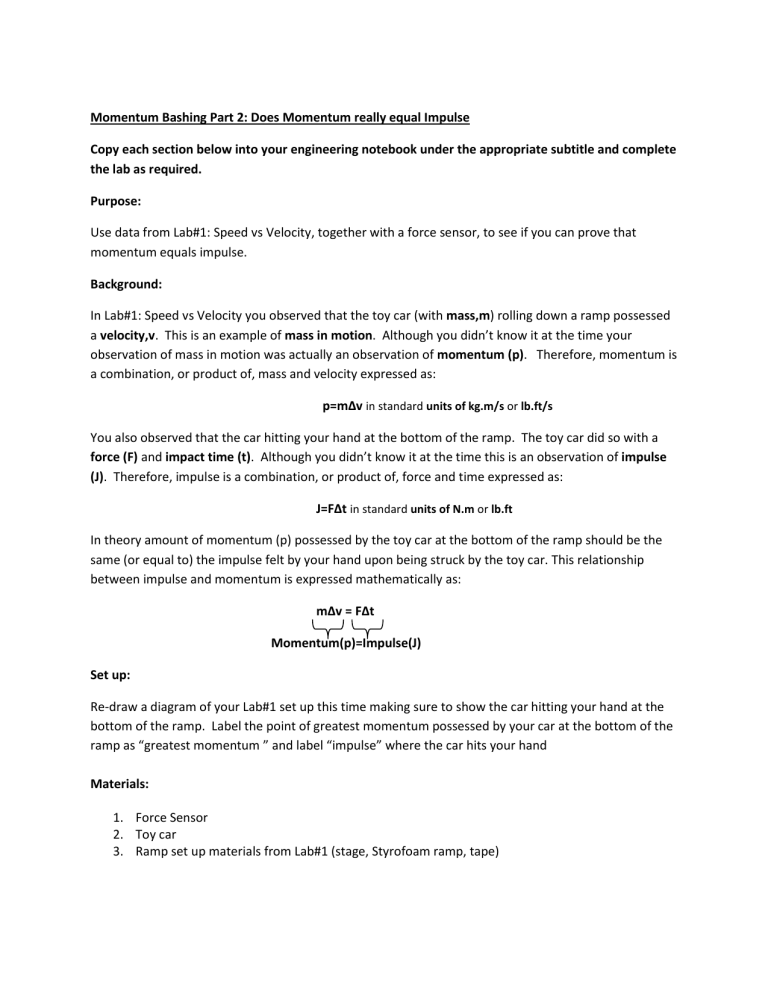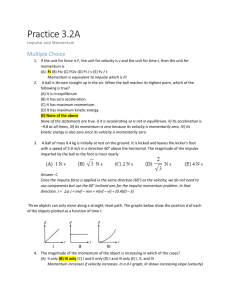Momentum Bashing Part 2: Does Momentum really equal Impulse

Momentum Bashing Part 2: Does Momentum really equal Impulse
Copy each section below into your engineering notebook under the appropriate subtitle and complete the lab as required.
Purpose:
Use data from Lab#1: Speed vs Velocity, together with a force sensor, to see if you can prove that momentum equals impulse.
Background:
In Lab#1: Speed vs Velocity you observed that the toy car (with mass,m) rolling down a ramp possessed a velocity,v. This is an example of mass in motion. Although you didn’t know it at the time your observation of mass in motion was actually an observation of momentum (p). Therefore, momentum is a combination, or product of, mass and velocity expressed as:
p=m∆v in standard units of kg.m/s or lb.ft/s
You also observed that the car hitting your hand at the bottom of the ramp. The toy car did so with a
force (F) and impact time (t). Although you didn’t know it at the time this is an observation of impulse
(J). Therefore, impulse is a combination, or product of, force and time expressed as:
J=F∆t in standard units of N.m or lb.ft
In theory amount of momentum (p) possessed by the toy car at the bottom of the ramp should be the same (or equal to) the impulse felt by your hand upon being struck by the toy car. This relationship between impulse and momentum is expressed mathematically as:
m∆v = F∆t
Momentum(p)=Impulse(J)
Set up:
Re-draw a diagram of your Lab#1 set up this time making sure to show the car hitting your hand at the bottom of the ramp. Label the point of greatest momentum possessed by your car at the bottom of the ramp as “greatest momentum ” and label “impulse” where the car hits your hand
Materials:
1.
Force Sensor
2.
Toy car
3.
Ramp set up materials from Lab#1 (stage, Styrofoam ramp, tape)
Procedure:
Part A: Mass of toy car
The force (due to gravity) acting on an object can be determined using a force sensor. The value determined can then be converted (using an online conversion tool) to a mass. You will record your final mass value in Part A: Data Collection section of your notebook. First, in your engineering notebook, write out a procedure that shows how you will determine the mass of your toy car in grams(g) using only the materials listed in the “Materials” section. Make sure you use the SAME car as in Lab #1. Use no
more than 4 steps.
Part B: Car velocity at bottom of ramp
Since we are interested in finding the velocity of the car at the bottom of the ramp (just before it hits your hand) we will need the average velocity(v) of your three best runs from Lab#1. Refer back to your snapshots of your three runs from Lab#1.
Part C: Force of impact
The force sensor can also be used to determine the force of impact between the car and your hand.
Write out a procedure that would allow you to determine the impact force (F) and the time (t) the impact lasted for, for the car released down the ramp and hitting your hand, using only the materials listed in the “Materials” section. Use no more than 5 steps.
Data Collection:
Before starting this section you must have your entire procedure verified and approved by Mr.Dacko
Part A:
Complete your Part A procedure and state your final mass (in grams) as Mass of car = _______g
Part B:
In your data collection section copy Table 1 below, follow Procedure B and record your 3 velocity values corresponding to the point at which the car is at the bottom of the ramp (hint: make sure to use the correct part of the graph). Then find the average velocity and record it in the proper place in Table #1.
Table 1: Velocity of Marble at bottom of ramp
Trial Velocity (m/s)
1
2
3
Avg.
Part C:
In your data collection section copy Table 2 below. Complete your Part C procedure and input all data into the table as required. Save a snapshot of your force graph
Table 2: Impulse data for marble hitting cup
Trial Force of impact (N) Time impact lasted (s)
1
2
3
Avg.
Analysis:
1.
Use the mass of your marble and the average velocity from Table 1 to calculate the momentum of your marble at the bottom of the ramp in units “g.m/s”. Show all work using GFS.
2.
Use the average force of impact and time of impact to calculate the impulse with which your marble hit the cup in units “N.s”. Show all work using GFS.
Synthesis:
1.
State your calculated values of for momentum and impulse. Are they similar?
2.
Does your answer to Q#1 support the impulse=momentum theory?
3.
Since theories don’t lie what happened in reality that might explain why your results are not exactly the same. List 3 possible reasons.
4.
If you were to perform this lab again with four marbles how might your momentum and impulse values be different?
5.
You are asked to invent a household device that can be used to flatten material thrown out into the green bin in order to fit more into it . Using the knowledge you have gained from this lab about momentum and impulse sketch a device that would meet these requirements and state how it would work being sure to make reference to terms like force, time, impulse, impact, velocity and mass.









